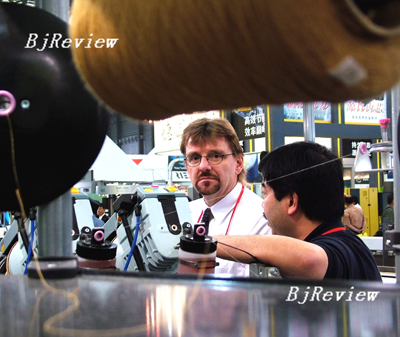
Since adopting` the reform and opening-up policy in the late 1970s, China has constantly expanded its foreign trade by giving full play to its comparative advantage in production cost. However, nowadays, problems previously camouflaged by high GDP growth have begun to emerge from the woodwork. Externally, China is faced with pressure on the yuan's appreciation resulting from the trade surplus, as well as trade frictions with the United States and the EU. Internally, the problem is excess liquidity due to over $1 trillion in foreign exchange reserves, coupled with a sizzling stock market and sharply rising housing prices. In a recent interview with 21st Century Business Herald, Professor Justin Yi-fu Lin from China Center for Economic Research, Peking University, who was the first person to introduce the concept of "comparative advantage" to China, responds to the many doubts people have about the theory. Excerpts:
21st Century Business Herald: The "comparative advantage" strategy is credited with driving China's economy over the past 20 years after the reform and opening-up policy was initiated, but nowadays, more and more people are beginning to feel suspicious of this strategy, believing that China's export-oriented development mode is responsible for the imbalance in economic structure and increasing trade surplus. Are these inevitable results of the "comparative advantage" strategy?
Justin Yi-fu Lin: According to the "comparative advantage" theory, products short of comparative advantages must be imported, while industries with comparative advantages can attract more capital and other resources and thus can develop quickly. The export process is much easier for these products. This is the case in China, since reform and opening up. However, to import or export is decided by the factor endowment structure, and never intentionally increased by anyone. Although nations following the "comparative advantage" strategy can export more than countries adopting the "catch-up" strategy, it's not wise to confuse a "comparative advantage" strategy with an export-led strategy.
Actually, comparative advantages come from comparison. Without government interference, industries with and without comparative advantages will respectively account for half of the foreign trade sector. Therefore, if a nation develops its economy by strictly keeping to the "comparative advantage" strategy, although it will more depend on trade than countries following the "catch-up" strategy, its exports and imports must be in a balance and, if not, the imbalance must be a temporary phenomenon resulting from industrial structure adjustment.
In accordance with the "comparative advantage" strategy, a country's imports and exports will reach a balance. Why does China have such a large surplus in foreign trade? Is it because of the export-oriented strategy?
There are several reasons for the current huge foreign trade surplus. First, it is the overheated investment, which has led to overcapacity.
Second, the big trade surplus also has something to do with the United States. As we know, Americans have a low savings rate and there is a fiscal deficit. It indicates that the U.S. market has a large demand, which will inevitably lead to a rise in the trade deficit. The United States is the world's largest economy, accounting for one third of the world total. In the mid-1990s, trade deficit only made up 1 percent of the U.S. gross domestic product, but now it has risen to more than 6 percent. Thus, inevitably, a trade surplus will result in some other countries. Actually, during this period of time, Japan and Germany also saw a sharp increase in trade surplus.
Third, capital-intensive products from some developed economies, especially the United States, should target the Chinese market, but apart from airplanes, these countries block the export of such products to China. As a result, we can't get what we hope to import. This situation is not created by China.
Fourth, the speculation on yuan appreciation results in an absurdly high trade surplus. Actually, since 2003, there has been mounting pressure on the revaluation of the Chinese currency. Speculators believe that the yuan will be appreciated by 20-30 percent. Since the yuan is not convertible under the capital account, some businesses have exaggerated export value while underreporting import value, hoping to increase their foreign currency reserves in order to profit from the supposed appreciation. When the exchange rate begins to rise sharply, this will happen in any country where the capital account is restricted. Between 1985 and 1987, Japan greatly appreciated its yen, with the rapid growth of current account surplus and foreign exchange reserves.
An inevitable assumption for the "comparative advantage" theory is the free flow of commodities among different countries, but this is not the case in reality. The impact of China's ever increasing export volume is much bigger than the reaction caused by the export-oriented strategies of the Four Asian Tigers. Is it possible for China to copy the model of the Four Asian Tigers?
Looking back at the 28 years since China adopted the reform and opening-up policy, in 1979, China's export volume was $13.66 billion and the import volume was $15.67 billion. The numbers respectively jumped to $593.32 billion and $561.23 billion in 2004. The growth rates of import and export volumes are almost the same. It was only in 2005 that trade statistics began to lose their accuracy because of expanding speculative capital.
Although China's rising exports are providing competition for other countries, the rising imports are also opening a big market for the rest of the world. There is some difference, however. While we are exporting labor-intensive products, what we import are capital-intensive products, that is to say,
|
